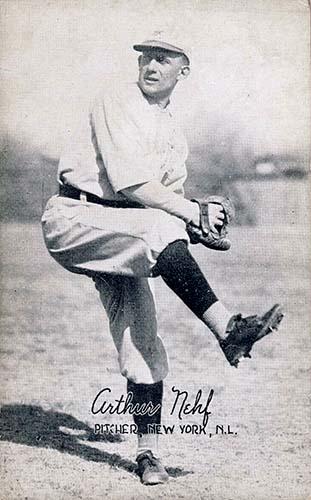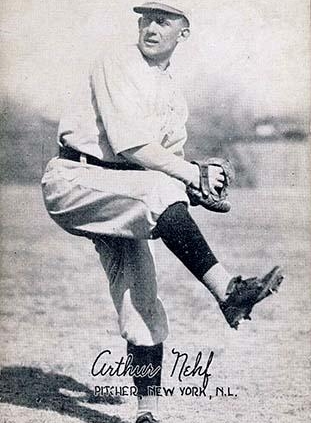September 26, 1921: Giants near pennant as Art Nehf wins 20th game
 On Friday, September 23, 1921, the New York Giants and St. Louis Cardinals were supposed to begin a three-game series in St. Louis. Friday’s game, however, was rained out and rescheduled for Monday, September 26, an open date for both teams. The Giants had to cancel an exhibition game that was to be played at Indianapolis that day.
On Friday, September 23, 1921, the New York Giants and St. Louis Cardinals were supposed to begin a three-game series in St. Louis. Friday’s game, however, was rained out and rescheduled for Monday, September 26, an open date for both teams. The Giants had to cancel an exhibition game that was to be played at Indianapolis that day.
The Monday game was of high importance to the Giants. As play began, the Giants led the National League with a 92-57 record. The second-place Pittsburgh Pirates, at 88-59, were three games behind but only two games back in the loss column.
The Giants had played well for the last month. On August 23 they were 7½ games behind the league-leading Pittsburgh Pirates. After sweeping the Pirates in a five-game series that began on August 24, New York trailed by 2½ games. After beating Brooklyn on September 9, the Giants moved into first place.
That victory was part of a 10-game winning streak from September 7 to September 17. Now in the lead, the Giants steadily expanded their advantage to 4½ games after taking their second game in two days from the Pirates on the 17th. By the September 26 game with the Cardinals, the Giants had won 22 of their last 29, including a split of their first two contests in St. Louis, and held a three-game lead over Pittsburgh. The Cardinals had five games remaining on their schedule; the Pirates had seven left.1
The Giants-Cardinals series presented an interesting contrast of managers. The Giants were managed by John McGraw, known for his fierce competitive spirit and aggressive baseball. The Cardinals were managed by Branch Rickey, known as a college-educated and religious gentleman. St. Louis, with an 84-64 record, was 7½ games behind the Giants and headed for their most wins and best winning percentage since they joined the National League in 1892. While the Cardinals had been eliminated from pennant contention, they led the Giants, 11 games to 10, in the season’s series.
The star of the game was the Giants’ starting pitcher, Art Nehf. The left-hander won his 20th game of the 1921 season that day. Nehf won 184 games in a career that spanned 15 National League seasons. From 1920 to 1922, Nehf won 60 games for the Giants. According to the New York Times game account, Nehf was “far too much and too many for the local host. He held Rickey’s slugging bunch to a handful of safe drives, and declined to allow any dangerous grouping of safeties.”2
The box score tells us that Nehf scattered five hits. The St. Louis Post-Dispatch account credited Nehf’s quick curve and observed that some of the five hits were scratch hits.3 While pitching a complete game, he struck out three and walked none Pitch counts weren’t included in 1921 box scores, but we can assume that Nehf pitched to contact, which was the predominant approach in the early lively ball era. Bill Klem was the home-plate umpire, and the game was over in a crisp 1:51, in contrast to today’s three-hour-plus games.
The offensive stars for the Giants were Frankie Frisch, Dave Bancroft, and Frank Snyder. Frisch had a double and two singles in four at-bats and scored one of the Giants’ four runs. Bancroft went 2-for-5, including a key triple, and stole a base, Bancroft was also a fielding star. He had three putouts and six assists. The Post-Dispatch assessed some of the plays as “spectacular.”4 Catcher Frank Snyder had two hits and drove in a run. No Cardinal had more than one hit. A Rogers Hornsby double – his 42nd of 1921, on his way to a league-leading 44 – was the only St. Louis extra-base hit.
The Giants threatened in the top of the second inning when cleanup hitter George Kelly’s fly ball was misplayed by right fielder Joe Schultz. Kelly got all the way to third base with nobody out. But St. Louis starter Bill Pertica got out of the jam. After Irish Meusel lined out to second base, Pertica struck out the next two batters.
The Giants broke through with the two deciding runs in the top of the third. With one out, George Burns singled to left. Dave Bancroft’s triple to left field scored Burns. Pertica’s wild pitch brought Bancroft home. Bancroft’s triple was the game’s big hit, and he was playing with injuries at the time. The triple resulted from a missed shoestring catch by Austin McHenry, the Cardinals’ left fielder.
The Cardinals threatened in the bottom of the third, when Doc Lavan led off with a single. The rally was extinguished quickly, when Nehf induced a double-play grounder to second by catcher Eddie Ainsworth. Nehf then struck out opposing pitcher Pertica.
In the top of the fourth, the Giants mounted a two-out rally. Johnny Rawlings singled to center and went to second on an error by center fielder Les Mann. This was one of five Cardinals errors in the game, and it was the only one that proved costly. Disdaining the intentional walk, Pertica pitched to the eight-hole hitter, catcher Snyder. But Snyder singled to center and Rawlings scored the third run.
The Cardinals bunched two of their five hits in the last of the fifth. Joe Schultz started the inning with a single and went to third on a single by McHenry. Doc Lavan’s sacrifice fly drove in Schultz. Nehf then retired the next two hitters on a fielder’s choice and a pop foul.
Another two-out rally resulted in the last Giants run, in the top of the seventh inning. Frisch doubled to left-center. Ross Youngs drew a walk. George Kelly, the Giants’ big RBI man, singled to center to drive in Frisch.
In the final totals, the winning Giants had four runs on 11 hits, with two errors. The Giants stranded 10 baserunners. The Cardinals scored one run on five hits against Nehf, while committing five errors. They left only two baserunners. This makeup game, on a Monday afternoon, drew 7,500 fans. Both the Times and the Post-Dispatch viewed the Monday ladies day crowd as a good one.5
At the end of the day, the Giants’ record was 93-57. Meanwhile, the Pirates lost at home to Philadelphia, 2-1. After the game, the Giants magic number was one to clinch a tie for the pennant, and two to win the flag. Immediately after the game, the Giants left for the long train ride home to New York. The trip took approximately 24 hours. According to the New York Times, the Giants, who had already canceled Monday’s exhibition game in Indianapolis to get in the makeup game in St. Louis, also canceled exhibition games scheduled for Tuesday and Wednesday in Baltimore. The Times report suggested that McGraw wanted to rest several injured players before the remaining three games, and the likely World Series. These injuries included both of Bancroft’s hands, and leg injuries to Frisch and Youngs.6
The Giants and the Cardinals ended the year with an 11-11 split of their season series. The Giants lost their season series with the rival Brooklyn Robins, 12 games to 10. The Giants’ 16-6 domination of Philadelphia was very helpful in their pennant quest. However, it was their 16-6 mark against second-place Pittsburgh that was decisive in the pennant race.
Sources
In addition to the sources cited in the Notes, the author consulted Baseball-Reference.com and Retrosheet.org.
https://www.baseball-reference.com/boxes/SLN/SLN192109260.shtml
https://www.retrosheet.org/boxesetc/1921/B09260SLN1921.htm
Notes
1 For a narrative of the competition for pennant in the closing days of the season, see Lyle Spatz and Steve Steinberg, 1921: The Yankees, The Giants and The Battle For Baseball Supremacy in New York (Lincoln: University of Nebraska Press, 2010), chapters 20 and 21, and pp. 300-302.
2 “Giants Down Cards as Corsairs Lose,” New York Times, September 27. 1921: 16.
3 “Art Nehf Shows Curves That Put Giants in Front,” St. Louis Post-Dispatch, September 27, 1921: 17.
4 “Art Nehf Shows Curves That Put Giants in Front.”
5 “Art Nehf Shows Curves That Put Giants in Front.”
6 “Giants Down Cards as Corsairs Lose.”
Additional Stats
New York Giants 4
St. Louis Cardinals 1
Sportsman’s Park
St. Louis, MO
Box Score + PBP:
Corrections? Additions?
If you can help us improve this game story, contact us.


